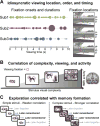A Closer Look at the Hippocampus and Memory
- PMID: 28625353
- PMCID: PMC5659202
- DOI: 10.1016/j.tics.2017.05.008
A Closer Look at the Hippocampus and Memory
Abstract
Current interpretations of hippocampal memory function are blind to the fact that viewing behaviors are pervasive and complicate the relationships among perception, behavior, memory, and brain activity. For example, hippocampal activity and associative memory demands increase with stimulus complexity. Stimulus complexity also strongly modulates viewing. Associative processing and viewing thus are often confounded, rendering interpretation of hippocampal activity ambiguous. Similar considerations challenge many accounts of hippocampal function. To explain relationships between memory and viewing, we propose that the hippocampus supports the online memory demands necessary to guide visual exploration. The hippocampus thus orchestrates memory-guided exploration that unfolds over time to build coherent memories. This new perspective on hippocampal function harmonizes with the fact that memory formation and exploratory viewing are tightly intertwined.
Keywords: episodic; exploration; eye-movement tracking; fMRI; long-term.
Copyright © 2017 Elsevier Ltd. All rights reserved.
Figures



References
-
- Eichenbaum H, Cohen NJ. From conditioning to conscious recollection: Memory systems of the brain. Oxford University Press; 2004.
-
- Underwood BJ. Attributes of memory. Psychol Rev. 1969;76:559–73.
-
- Otero-Millan J, et al. Saccades and microsaccades during visual fixation, exploration, and search: foundations for a common saccadic generator. J Vis. 2008;8(14):21, 1–18. - PubMed
-
- Hollingworth A, Henderson JM. Accurate visual memory for previously attended objects in natural scenes. Journal of Experimental Psychology-Human Perception and Performance. 2002;28(1):113–136.
-
- Zelinsky GJ, Loschky LC. Eye movements serialize memory for objects in scenes. Percept Psychophys. 2005;67(4):676–90. - PubMed
Publication types
MeSH terms
Grants and funding
LinkOut - more resources
Full Text Sources
Other Literature Sources
Medical

